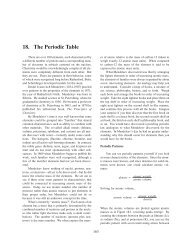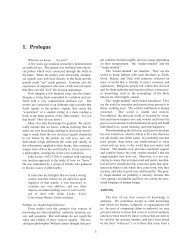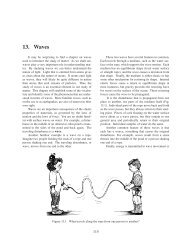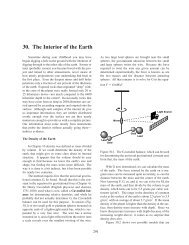You also want an ePaper? Increase the reach of your titles
YUMPU automatically turns print PDFs into web optimized ePapers that Google loves.
Figure <strong>20</strong>.2. Lithium orbital energies split <strong>and</strong> form many energy levels that are very close together as more <strong>and</strong> more<br />
atoms are added.<br />
Figure <strong>20</strong>.3. Malleability of a metal. (a) Forces applied to a group of metal atoms. (b) The solid deforms, but will<br />
spring back to its original shape if the force is removed. (c) The solid is deformed permanently by layers sliding to new<br />
positions.<br />
drift from one orbital to another through the overlapping<br />
regions to any part of the lump of metal.<br />
The drifting electrons give metals their unique<br />
properties, the most common of which are discussed<br />
below.<br />
1. Electrical conductivity. If electrons are<br />
forced into one end of a piece of metal, they<br />
push other mobile electrons out the other end.<br />
This is the mechanism by which wires carry<br />
electricity <strong>and</strong> is called electrical conductivity.<br />
2. Metallic luster. The closely spaced energy<br />
levels shown in Figure <strong>20</strong>.2 permit metals to<br />
absorb virtually every visible wavelength of<br />
light <strong>and</strong> many invisible wavelengths. A photon<br />
of almost any energy can find an energy<br />
gap that just fits. However, the atoms do not<br />
keep the photons, but immediately radiate<br />
them back (reflection). If all of the visible<br />
light is reflected, the metal appears silver, or if<br />
it is roughened, it appears white. If some of<br />
the violet <strong>and</strong> blue light is permanently<br />
absorbed, the metal appears gold or copper<br />
colored. High reflectivity in at least a part of<br />
the visible spectrum confers metallic luster.<br />
3. Malleability. Things like glass shatter when<br />
hit with a hammer, but most metals simply<br />
bend or flatten, particularly if they are hot. For<br />
example, gold can be pounded thinner than<br />
paper (to about a millionth of a centimeter<br />
thickness). This characteristic response to<br />
force is termed malleability. On the microscopic<br />
level, the metal nuclei must slide past<br />
each other into new positions without ever<br />
substantially weakening the metallic bond.<br />
The sea of mobile electrons flows wherever it<br />
is needed to keep the bonds strong during<br />
bending <strong>and</strong> flattening operations (Fig. <strong>20</strong>.3).<br />
4. Thermal conductivity. If thermal energy is<br />
added to a piece of metal, the kinetic energy of<br />
the electrons is increased. The electrons move<br />
rapidly through the metal distributing this<br />
kinetic energy throughout by collisions. Thus,<br />
the whole piece of metal becomes hot much<br />
sooner than an equivalent piece of nonmetal.<br />
This transport of thermal energy is termed<br />
thermal conductivity.<br />
5. Chemical reactivity. The mobile electrons<br />
are easy prey for electron-hungry atoms such<br />
as oxygen, so most metals react easily to form<br />
oxides or other compounds with nonmetals. In<br />
fact, only a few metals (such as gold, silver,<br />
184








